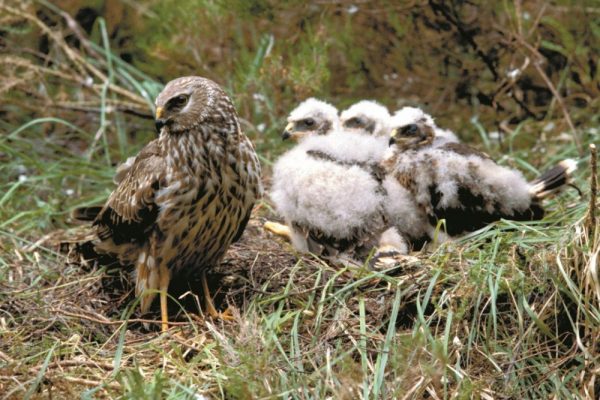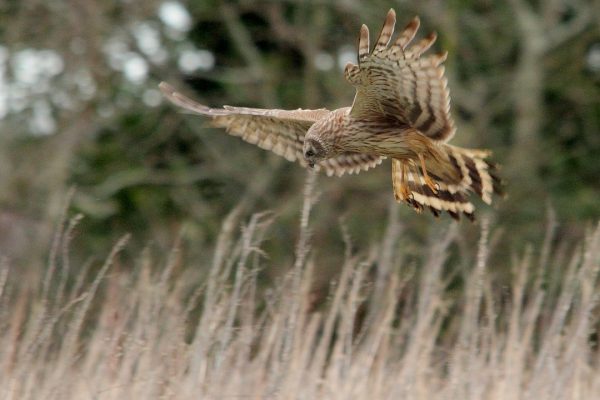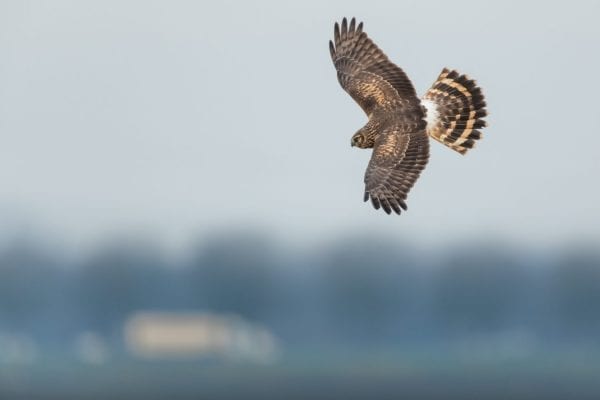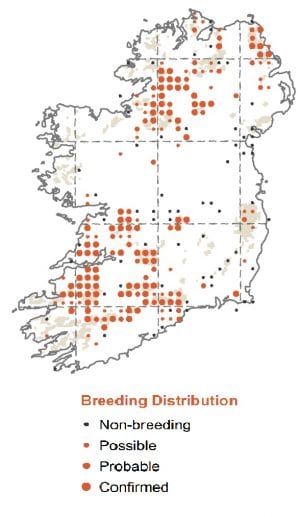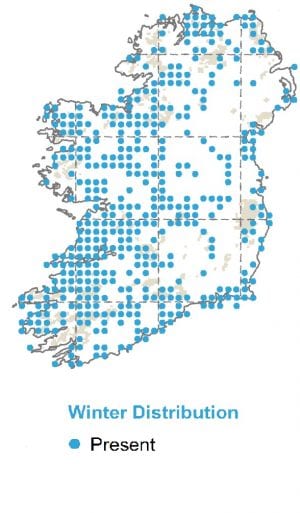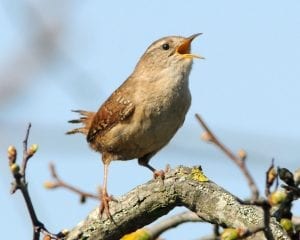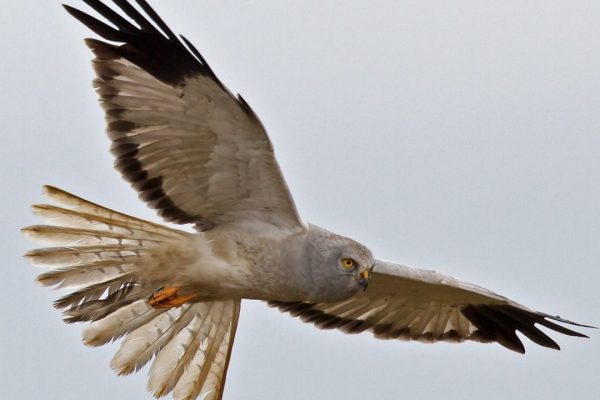
Hen Harrier
| Irish Name: | Cromán na gCearc |
| Scientific name: | Circus cyaneus |
| Bird Family: | Raptors |
amber
Conservation status
Conservation status
Status
Breeds in the uplands and bogs of Ireland.
Identification
Size between Montagu's Harrier and the larger Marsh Harrier. Females and juveniles similar - brown with white rump and dark rings on the tail, hence often referred to collectively as 'ringtails'. Females are bigger than males. Males very distinctive, appearing strikingly pale below, with blue grey upper parts and jet black wing-tips. Hen Harriers have somewhat of an owl-like face, particularly accentuated in female birds.
Voice
Usually only heard in the breeding season near the nest site. Quick, chattering calls in alarm and display and whistling calls from female to male, when receiving food.
Diet
Small birds and mammals, which are caught by surprise. Will sometimes use cover, such as woodland edges and bushes, to surprise prey.
Breeding
Breeding birds are confined largely to heather moorland and young forestry plantations, where they nest on the ground. Hen Harriers are found mainly in Counties Laois, Tipperary, Cork, Clare, Limerick, Galway, Monaghan, Cavan, Leitrim, Donegal and Kerry. The species has declined, probably due to the loss of quality moorland habitat due to agricultural changes, and maturing forest plantations. Hen Harriers mainly hunt over moorland whilst breeding where they take small ground nesting birds and mammals.
Wintering
Spends winter in more coastal and lowland areas throughout Ireland hence most easily seen on the coast in the winter months. Good sites include the North Slob Nature Reserve and Tacumshin Lake in County Wexford, as well as the East Coast Nature Reserve in Co. Wicklow.
Monitored by
BirdTrack and the Hen Harrier Roost Survey.
Blog posts about this bird
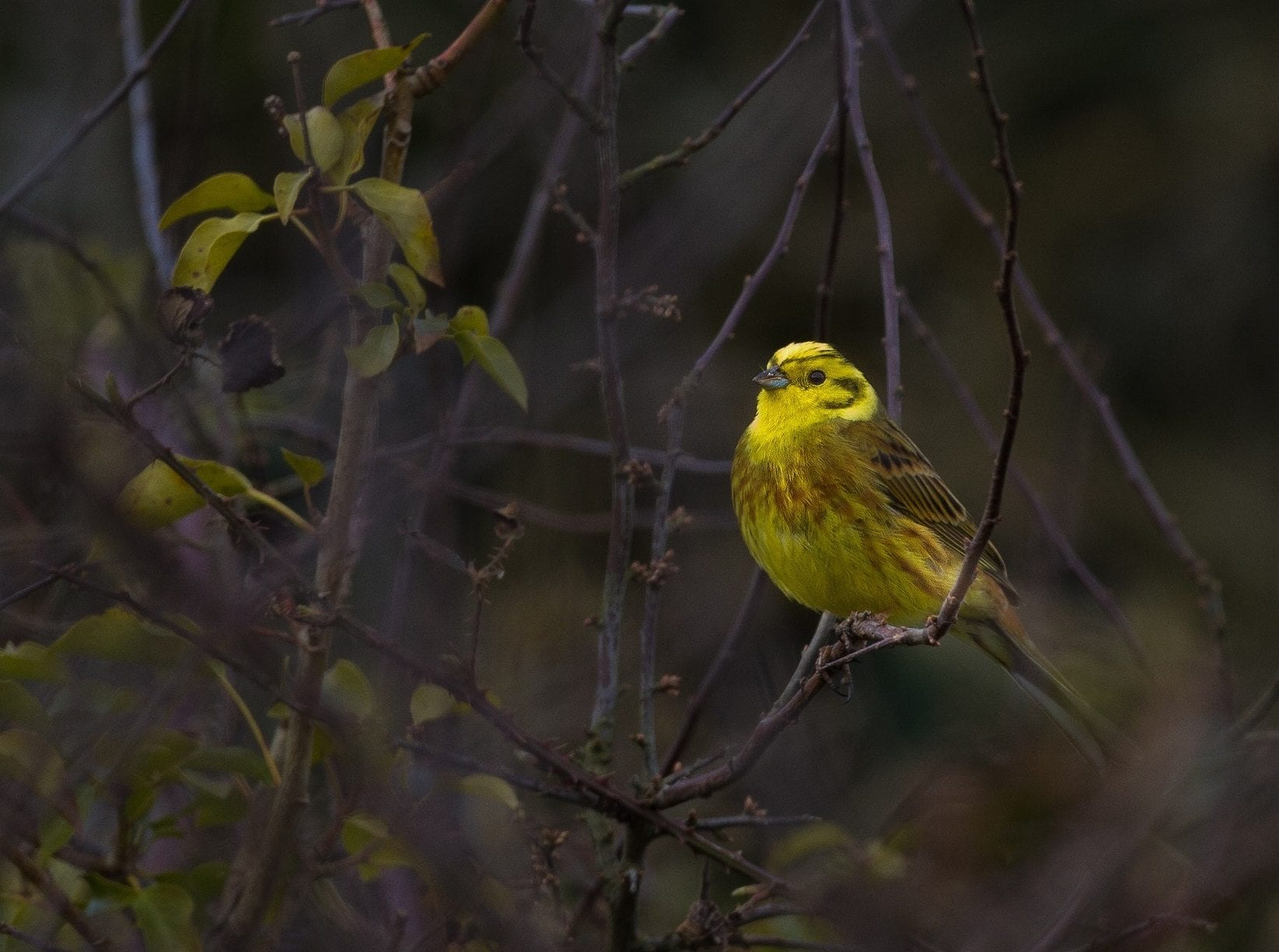
Nesting Season 101 – Hedge-cutting and the Law
Birds in Ireland are facing pressures from all sides, with habitat loss and fragmentation, predation, disturbance and climate change just some of the things they have to contend with. Nesting birds and their young are particularly vulnerable and, while it is vital that we don’t interfere with wild birds at this time, there are some things you can do to support birds during nesting season. One of the easiest ways to do so is to abide by existing laws around hedge-cutting and vegetation burning.
Hedge-cutting and vegetation burning ban
Under the Wildlife Act, it is against the law to cut, burn or otherwise destroy vegetation including hedges between March 1st and August 31st. The purpose of this ban is to prevent the disturbance and destruction of nesting sites of many of our wild bird species.Hedge-cutting
Hedges provide important nesting sites for many wild birds – including Robin, Wren, Blackbird, and Dunnock, to name a few – as well as a bounty of food for a variety of other species. They also offer shelter and safe routes for wildlife to travel along, known as wildlife corridors. Hedges offer numerous benefits to humans including food, natural property boundaries, shelter for crops and livestock, noise reduction and visual appeal. As healthy hedges also sequester and store atmospheric carbon, and help to slow water movement and prevent flooding, they are absolutely vital in mitigating the effects of climate change. The annual ban on hedge-cutting applies to private gardens as much as it does to farms and the wider countryside. While some green-fingered folk may argue that, with a steady hand, they can leave a nest unshaken, the sheer act of getting that close to the hedge and nests within it could be enough for the adult birds to abandon it. Without their parents, the eggs and chicks in the nest have virtually no hope of survival. If they don’t succumb to starvation due to lack of food delivery by an adult bird, they are likely to be victims of predation. 63% of regularly occurring Irish birds are of serious conservation concern, with 26% of them now Red-listed species of conservation concern and 37% Amber-listed species of conservation concern. With the decline in bird populations directly linked to the loss and degradation of habitat, it is important that we do all we can to preserve what remains. You can play your part in this by leaving your hedges alone during the nesting season, and by spreading the word to others.Wren. Photo: Michael Finn.
Vegetation Burning
The Wildlife Act also prohibits the burning of vegetation during the nesting season. This is aimed at protecting our ground-nesting bird species in upland habitats, many of which have seen their populations plummet in recent decades. This includes species such as Curlew, Lapwing, Skylark, Meadow Pipit and Hen Harrier. While burning is not the only cause of the decline of these species, it does pose a significant threat to their breeding success when carried out during the nesting period. But even during the 'open season' for burning, out-of-control fires, can have devastating consequences on habitats sometimes 'melting' peat soils due to the heat and destroying their functions as carbon stores and sinks as well as habitats for wildlife, for years. Illegal fires during the closed period can lead to the destruction of nests and young of these already vulnerable species, as well as the disturbance of breeding adults. Additionally, such burning can damage habitats that are protected in their own right such as Raised Bog and Blanket Bog. In addition to being unique and biodiverse habitats, our bogs serve as carbon sinks, meaning that they play a huge role in mitigating the effects of climate change.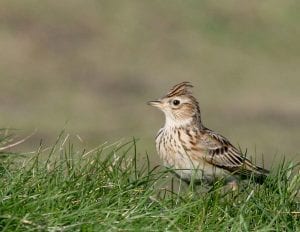
Reporting illegal cutting and burning
Despite the ban on hedge-cutting between March 1st and August 31st, it is possible that you will come across cutting and burning during this period. Indeed, the Wildlife Act does have exemptions which allow hedge-cutting during the closed period, for example, should there be road safety concerns. In saying this, regardless of who is involved, don’t assume that those cutting the hedge have received the green light to do so. It may well be that they are breaking the law. If you witness hedge-cutting or burning in any place or at any time during this period, please report it to the local Gardaí and the National Parks and Wildlife Service (NPWS). You can read the NPWS guidance on reporting Wildlife Crime here and find contact details for your local NPWS Wildlife Ranger here.Enforcement of the Wildlife Act
Efforts to tackle wildlife crime in Ireland have been strengthened in recent times. Forty-three prosecution cases were initiated by NPWS in 2023 for alleged breaches of wildlife legislation, a 39% increase since 2022. Wildlife crimes reported range from the disturbance of bats, illegal hunting, damage to Special Areas of Conservation (SACs), destruction of hedgerows and burning of vegetation within the restricted period, and more. This increase in action against wildlife crime is very much welcomed by us at BirdWatch Ireland. However, there is still work to be done. It is widely known that our wildlife legislation is not as strongly enforced as it could be, and that the initiation of cases and rates of conviction are higher in some locations than others. There are a number of reasons for this including a general lack of training and resources in the area of wildlife crime in both the National Parks and Wildlife Service (NPWS) and An Garda Siochána, and difficulty in gathering sufficient evidence on certain forms of wildlife crime. With this in mind, if you witness any other form of wildlife crime, or simply are worried about the situation for wildlife in this country, we would encourage you to also contact your local and national elected representatives to voice your concerns.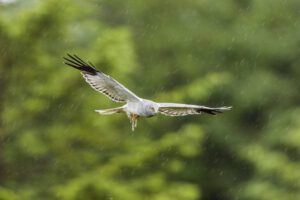
Early and Late Nesting Birds
While the ban on cutting and burning begins in March and will be lifted at the beginning of September, we strongly encourage you to leave your hedges for longer than the closed period. Unlike humans, birds don’t use calendars to determine their schedules! As the subject is understudied here, much of what we know about nesting is derived from UK data. However, owing to our milder climate, we likely have a potentially earlier onset to the nesting season in Ireland. Climate change has also caused a shift in birds' annual cycles, with milder temperatures leading some species to nest earlier in the year. We do have evidence of late nesters including the Red-listed Yellowhammer, the species with the latest fledging date. While the current legislation permits hedges to be cut from September 1st, at this time, approximately 5% of Yellowhammers may still have chicks in the nest. Hen Harrier may also still have unfledged chicks in the nest into late September. Until we have data on nest-building periods in Ireland, we advocate for a cautionary approach when it comes to hedgerow management and vegetation burning, particularly during these fringe periods.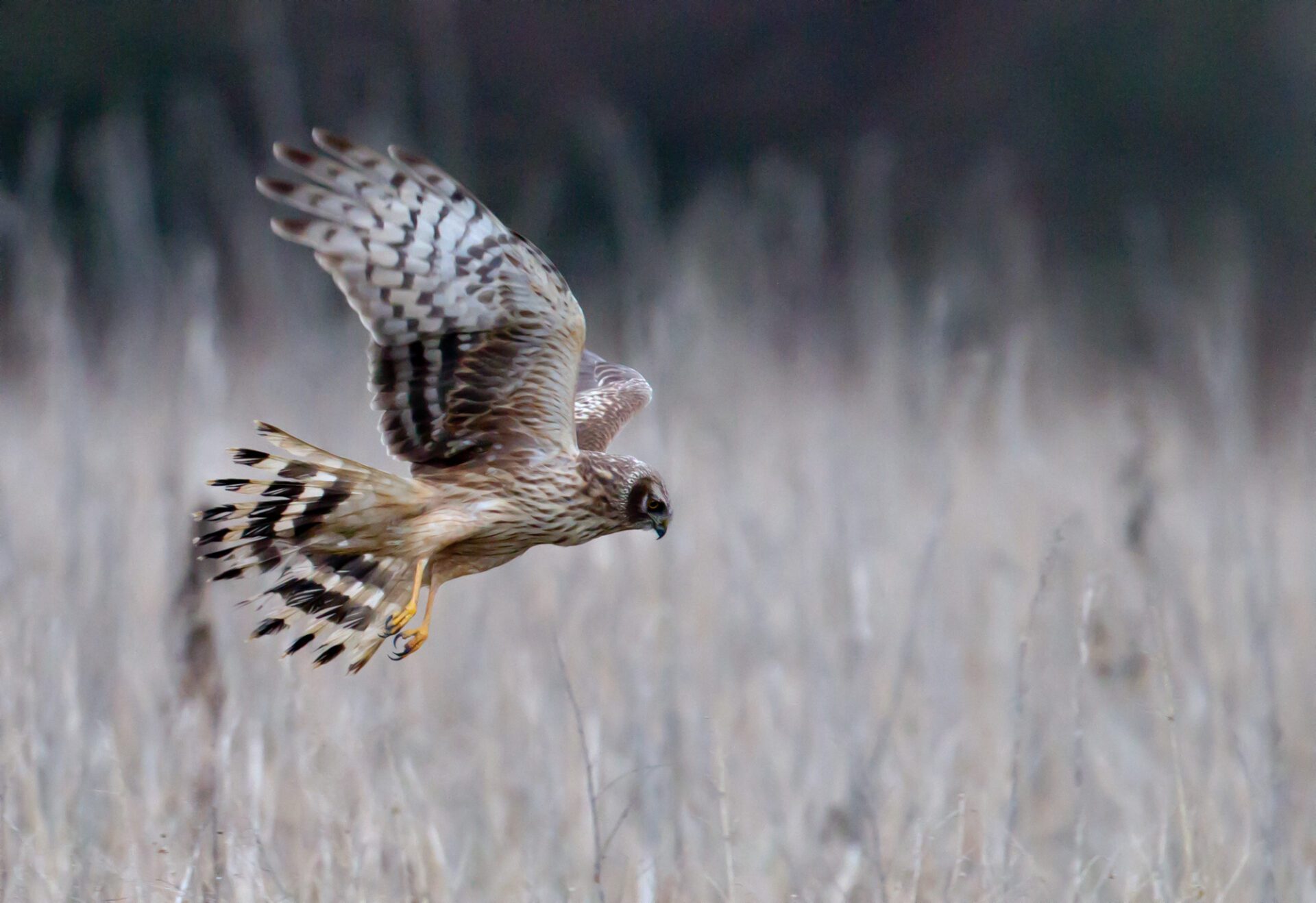
BirdWatch Ireland, An Taisce and Environmental Pillar urge public to get behind their “Save the Skydancer” Campaign in light of stark Hen Harrier decline
Without urgent action, we may have just 25 years until the Hen Harrier and its captivating skydance are erased from Ireland’s uplands forever.
This is according to BirdWatch Ireland, An Taisce and the Environmental Pillar, who are urging people across the country to call for a government commitment to the protection of this mesmerising bird of prey before it is too late.
As members of the Irish public, we are witnessing the disappearance of the Hen Harrier before our eyes. Results of the 2022 National Survey of Hen Harrier in Ireland show that time has almost run out for the Hen Harrier, and that the species is now faring even worse than the Curlew and the Corncrake – species often held up as prime examples of biodiversity loss in Ireland. Since the last national survey of what is one of Ireland’s rarest birds, the species has declined by one-third in just seven years, with just 85-106 breeding pairs estimated to remain in the country. Without strong and swift intervention, the Hen Harrier faces the very real prospect of extinction in Ireland in just 25 years, its skydance and chattering call no longer gracing our uplands.
As the Hen Harrier is one of the most heavily researched birds in Ireland, we know what we need to do to save it. We welcome that the draft Hen Harrier Threat Response Plan (HHTRP) appropriately identifies the pressures that have brought about the significant population declines. However, while the ongoing declines should serve as alarm bells, the draft Hen Harrier Threat Response Plan does not reflect the gravity of the current situation.
BirdWatch Ireland, An Taisce and the Environmental Pillar are concerned by the Actions listed in this plan which, due to being vague and not sufficiently targeted will fail to protect the Hen Harrier from the key pressures of forestry and wind energy. The plan fails to outline a clear plan to restore the species habitat, which essentially make it impossible to measure the adequacy of the plan and mean it will not deliver for Hen Harrier.
John Lusby Raptor Conservation Officer with BirdWatch Ireland said: “The draft Hen Harrier Threat Response Plan has been in development for more than ten years, during which time the Hen Harrier population has declined by one-third, we are running out of time, and the draft plan in its current form does not reflect that urgency nor is it sufficiently targeted to implement the actions needed. We need more from the Hen Harrier Threat Response Plan, otherwise we are facing the very real and shameful prospect of losing the Hen Harrier within our lifetimes.”
Oonagh Duggan Head of Advocacy at BirdWatch Ireland said: “The power to address the pressures and threats to the Hen Harrier lies with several government bodies but instead the message seems to be one of quietly quitting on this majestic bird of prey when you see the lack of ambition in the draft Hen Harrier Threat Response Plan. We need national leadership now and whole-of-government drive and ambition to halt the losses and restore Hen Harrier populations with a strong, effective, clear and measurable Plan. Critical habitat restoration measures would also be a win-win for climate targets as Hen Harriers often nest on peat-based habitats. We call on members of the public to urgently go to the Hen Harrier page on the BirdWatch Ireland website to send a submission to save the Skydancer.”
Environmental Pillar Steering Committee Member and Head of Advocacy at An Taisce, Dr Elaine McGoff said: “We’re really at a crisis situation in relation to the Hen Harrier which is in grave danger of becoming extinct. A key reason for this collapse is the loss of heather and grassland habitats in our uplands due to forestry, wind energy development and agricultural intensification. We need more than vague, or worse, virtually no commitments from the Government to save the Hen Harrier. We need action that includes protecting breeding and wintering sites and that restores habitats and we’re asking the public to support us.”
Fintan Kelly, Agriculture and Land Use Policy and Advocacy Officer with the Environmental Pillar, said: “The results of the most recent survey make for grim reading. The current draft Hen Harrier Threat Response Plan to protect the status of the Hen Harrier and its habitats represents a catastrophic and unacceptable failure by the State. We need a much more ambitious approach to saving this iconic bird from extinction. And we need the Irish public to tell the Government that it wants a workable plan to save the skydancer. We are asking the Irish people to send a submission to the National Parks and Wildlife Service outlining our key asks.”
We know that, to save the Hen Harrier, The Hen Harrier Threat Response Plan must be ambitious and fit-for-purpose.
In order to restore Ireland’s Hen Harrier population, we believe any plan must:
- Protect all nationally important Hen Harrier breeding and wintering grounds from afforestation, forest management activities, wind energy development and other pressures.
- Restore habitat across all nationally important breeding and wintering sites using clear restoration targets and timelines.
- Guarantee long-term support for farmers through well-funded results-based schemes across all nationally important breeding and wintering grounds.

